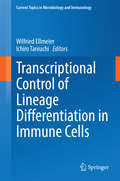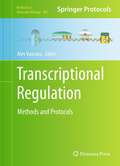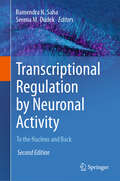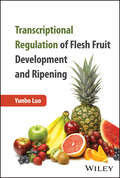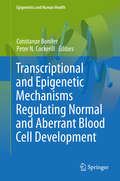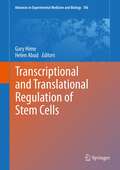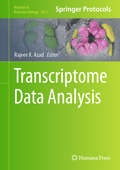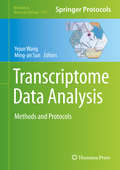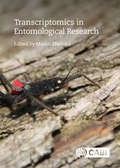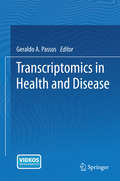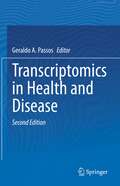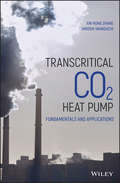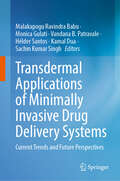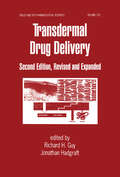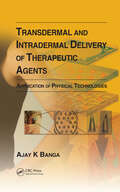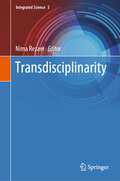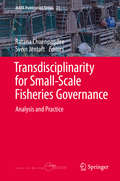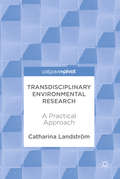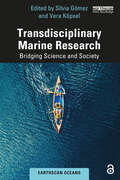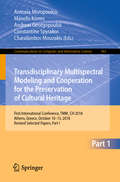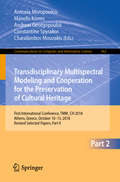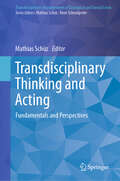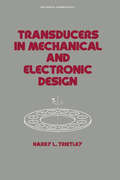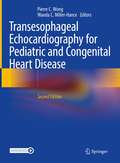- Table View
- List View
Transcriptional Control of Lineage Differentiation in Immune Cells
by Wilfried Ellmeier Ichiro TaniuchiInsights into the regulation of immune cell lineage differentiation and specification as well as into the control of lineage integrity, stability and plasticity are of fundamental importance to understanding innate and adaptive immune responses. In this volume, leading experts provide an up-to-date and comprehensive overview of recent advances in the transcriptional control mechanisms and transcription factor networks that regulate these processes in a variety of different immune cell lineages. The chapters cover the regulation of T versus B cell lineage choice, discuss early B cell development and pre-B cell leukemia prevention, address transcriptional control mechanisms during the differentiation, in regulatory T cells and iNKT cells, detail genomic switches in helper cell fate choice and plasticity and highlight the role of the BTB-zinc finger family of transcription factors in T cells. Moreover, the chapters discuss transcriptional networks in DCs, NK cells and in innate lymphoid cells. Together, the reviews illustrate key transcriptional control mechanisms that regulate the development and function of immune cells and demonstrate the impressive advances made over the last decade.
Transcriptional Regulation
by Ales VancuraThrough many recent remarkable developments, perhaps the most significant advancements in the study of transcriptional regulation are the development of genome-wide approaches for measuring gene expression, exemplified by gene chips (chip), and chromatin immunoprecipitation assays (ChIP) for measuring in vivo protein-DNA interactions at any genomic loci. Transcriptional Regulation: Methods and Protocols takes this progress and builds upon it with a collection of key protocols used in expert laboratories around the world. Divided into four convenient sections, this detailed volume explores promoter elements, transcription factors, and preinitiation complex (PIC) assembly, chromatin structure, chromatin modifying complexes, and RNA synthesis and regulation. Written in the highly successful Methods in Molecular BiologyTM series format, chapters include introductions to their respective topics, lists of the necessary materials and reagents, step-by-step, readily reproducible laboratory protocols, and vital tips on troubleshooting and avoiding known pitfalls. Comprehensive and accessible, Transcriptional Regulation: Methods and Protocols equally serves senior researchers and scientists experienced in transcriptional regulation as well as graduate students and scientists who wish to study transcriptional regulation for the first time.
Transcriptional Regulation by Neuronal Activity: To the Nucleus and Back
by Ramendra N. Saha Serena M. DudekThis book discusses the regulation of gene transcription by neuronal activity that is evident in a large number of neuronal processes ranging from neural development and refinement of neuronal connections to learning and response to injury. Transcriptional Regulation by Neuronal Activity: To the Nucleus and Back, 2nd edition illustrates how signals are transmitted to the nucleus in response to neuronal activity, which genes are regulated and how this is achieved, and how these changes in gene expression alter neuronal function. The aim of this second edition is to highlight key advances in the field since the first edition. The book is divided into four sections. The first highlights how signals get to the nucleus from the membrane in response to synaptic or neuronal activity. Included are chapters on the pathways that transmit signals from synapses to nuclei. The second section focuses on epigenetic regulatory processes of activity-induced gene transcription, an area that has exploded in the past few years. The third section navigates the role of activity-induced genes in physiological processes such as learning and memory, and human developmental disorders such as those associated with the autism spectrum. The fourth section highlights groundbreaking technological advances in the field, which have allowed activity-regulated transcription to be used as a tool to study learning and memory.
Transcriptional Regulation of Flesh Fruit Development and Ripening
by Yunbo LuoTranscriptional Regulation of Flesh Fruit Development and Ripening Understand the critical factors in fruit development with this up-to-date guide Fruit is an essential part of the human diet, and fruit production has never been more central to global human nutrition and public health. Fruit ripening is a vital stage in the emergence of nutrient-rich food, and modifications to the fruit development process can impact flavor, texture, nutritional value, and more. The process of ripening is controlled by nearly sixty transcription factors (TFs), a proper understanding of which is therefore crucial to regulating fruit quality and competing in the global food marketplace. Transcriptional Regulation of Flesh Fruit Development and Ripening is a comprehensive introduction to recent developments in the study of fruit ripening, focusing especially on these transcription factors. It details the major families of transcription factors and their properties, as well as providing methods for screening and identifying transcription factors to aid in genetic modification of fruit. The result is a thorough, accessible reference to a critical set of factors in fruit development. Transcriptional Regulation of Flesh Fruit Development and Ripening readers will also find: Detailed regulation of transcription factor families including MADS-box, NAC, ethylene response factor, and more Discussion of both climacteric and non-climacteric fruits throughout Analysis of how multiple TFs interact to influence fruit ripening Transcriptional Regulation of Flesh Fruit Development and Ripening is a must-have volume for food scientists, horticultural researchers, agriculturalists, and graduate students working in these or related fields.
Transcriptional and Epigenetic Mechanisms Regulating Normal and Aberrant Blood Cell Development
by Constanze Bonifer Peter N. CockerillDuring vertebrate hematopoiesis many specialized cell types are formed with vastly different functions such as B cells, T cells, granulocytes, macrophages, erythrocytes and megakaryocytes. To tightly control the enormous proliferative potential of developing blood cells, an intricately balanced signaling and transcription network has evolved that ensures that the different cell types are formed at the right time and in the right numbers. Intricate regulatory mechanisms ensure that blood cells function properly and have a determined life span. Moreover, in the adaptive immune system, long-lived memory cells have evolved that ensure that when pathogens have been seen once they will never cause a problem again. In this book we will therefore make a journey from asking how more primitive organisms use the epigenetic regulatory machinery to balance growth with differentiation control towards digging deep into what controls the function of specialized cells of the human immune system. We will first discover that flies make blood but exist without blood vessels, why fish make blood cells in the kidney and which precise genetic circuitries are required for these developmental pathways. We will then learn the regulatory principles that drive the differentiation of mature blood cells from stem cells and what controls their function in mammals. In the process, we will find out what unites hematopoietic stem cells and endothelial cells. Finally, we will shed light on the molecular mechanisms that either alter hematopoietic cell differentiation or lead to the development of cells with impaired function.
Transcriptional and Translational Regulation of Stem Cells
by Gary Hime Helen AbudThis volume describes the latest findings on transcriptional and translational regulation of stem cells. Both transcriptional activators and repressors have been shown to be crucial for the maintenance of the stem cell state. A key element of stem cell maintenance is repression of differentiation factors or developmental genes - achieved transcriptionally, epigenetically by the Polycomb complex, and post-transcriptionally by RNA-binding proteins and microRNAs. This volume takes two approaches to this topic - (1) illustrating the general principles outlined above through a series of different stem cell examples - embryonic, iPS and adult stem cells, and (2) describing several molecular families that have been shown to have roles in regulation of multiple stem cell populations.
Transcriptome Data Analysis (Methods in Molecular Biology #2812)
by Rajeev K. AzadThis detailed volume presents a comprehensive exploration of the advances in transcriptomics, with a focus on methods and pipelines for transcriptome data analysis. In addition to well-established RNA sequencing (RNA-Seq) data analysis protocols, the chapters also examine specialized pipelines, such as multi-omics data integration and analysis, gene interaction network construction, single-cell trajectory inference, detection of structural variants, application of machine learning, and more. As part of the highly successful Methods in Molecular Biology series, chapters include the kind of detailed implementation advice that leads to best results in the lab. Authoritative and practical, Transcriptome Data Analysis serves as an ideal resource for educators and researchers looking to understand new developments in the field, learn usage of the protocols for transcriptome data analysis, and implement the tools or pipelines to address relevant problemsof their interest. Chapter 4 is available open access under a Creative Commons Attribution 4.0 International License via link.springer.com.
Transcriptome Data Analysis: Methods And Protocols (Methods In Molecular Biology #1751)
by Yejun Wang Ming-An SunThis detailed volume provides comprehensive practical guidance on transcriptome data analysis for a variety of scientific purposes. Beginning with general protocols, the collection moves on to explore protocols for gene characterization analysis with RNA-seq data as well as protocols on several new applications of transcriptome studies. Written for the highly successful Methods in Molecular Biology series, chapters include introductions to their respective topics, lists of the necessary materials and reagents, step-by-step, readily reproducible laboratory protocols, and tips on troubleshooting and avoiding known pitfalls. Authoritative and useful, Transcriptome Data Analysis: Methods and Protocols serves as an ideal guide to the expanding purposes of this field of study.
Transcriptomics from Aquatic Organisms to Humans
by Libia Zulema Rodriguez-Anaya Cesar Marcial Escobedo-BonillaNovel molecular techniques, such as next-generation sequencing, are used to measure gene expression after exposure to a certain stimulus. Data using these gene expression techniques are highly accurate, sensitive and generate transcriptional profiles from species including humans, fish and crustaceans. This book includes transcriptomic studies of non-infectious and infectious diseases affecting humans and environmental and physiological correlates affecting shrimp and fish aquaculture. The book is intended for undergraduate and graduate students interested in one of the various research areas transformed by transcriptomics, including human disease, fish and crustacean physiological, environmental and farming issues. Key Features Documents the utility of next-generation sequencing and RNA-seq to a wide array of aquatic environmental and physiological issues as well as to human health Provides insights into the ways transcriptomics can contribute to the understanding of various research subjects such as aquatic animals, fish ecology and human diseases Presents an account of the evolution of the techniques used to determine the transcriptome in crustacean aquaculture Describes the mechanisms of genetic interactions between different pathogens and the human host and their effects modifying gene expression levels
Transcriptomics in Entomological Research
by Patrick Von Aderkas May R Berenbaum Bernarda Calla Joanna C. Chiu Jürgen Ehlting Melanie Gee Aman Gill Martin Hasselmann Matthew Huff Brian R Johnson Juan Luis Jurat-Fuentes William E Klingeman Kyle M. Lewald Shanlin Liu Antonino Malacrinò Guanliang Meng Yoonseong Park Amber Rose Paulson Steven J Perlman Ratnasri Pothula Sampurna Sattar Margaret E Staton James P Tauber Gary A Thompson Will Kipling Chengran ZhouBridging the gap between genome and phenotype, the transcriptome is a molecular-level snapshot of the act of living. Transcriptomics shows which genes are expressed into proteins in a specific tissue of a specific organism at a specific time and condition. This book gives an account of the extraordinary diversity of ways transcriptomics has been and can be utilised in basic and applied entomological research. It encompasses a vast range of disciplines within entomology, applying transcriptomics to the study of over one million described species of insects. It covers a vast range of disciplines from phylogenomics to pest management, from ecology to physiology, and from behavior to evolutionary biology. The book covers the breadth and depth of transcriptomics use in research to showcase the utility of this technology in all disciplines. Research examples in the book are relevant to fish, birds, plants, and fungi, as well as insects and other arthropods, helping scientists in any field, using any system, to understand what transcriptomics can do for them. The book: Introduces transcriptomics theory and practice for researchers of all levels wishing to gain an insight into how to apply these techniques to their own fields. Showcases the myriad ways transcriptomics can be used to answer biological questions. Is written by a team of international experts describing their own experiences, giving guidance for applying it to the reader's own work. Reviews how transcriptomics research has helped entomologists push their fields further and make new discoveries.
Transcriptomics in Health and Disease
by Geraldo A. PassosAfter sequencing the human genome a decade ago, researchers have continued their projects, but now to try to better understand how, and when, genes are expressed in health and disease. Efforts have been concentrated on the measurement of the expression of RNA transcripts. In an analogy to the genome, the term "transcriptome" was created to refer to the complete set of RNAs in a cell type or tissue in a particular situation. Transcriptomics is the science that studies this issue and it is a branch of functional genomics. Transcriptomics in Heath and Disease provides a comprehensive overview of the science of transcriptomics initially in health, focusing on the concept of the transcriptome and the main methods to evaluate it. The authors discuss the concept and use of gene expression signatures and transcriptional biomarkers in normal development and diseased tissues and organs. As the transcriptome changes depending on the pathology, there is also a focus on the variations in the gene expression in different diseases such as autoimmune, inflammation, cancer and infections. This book should be very useful for researchers in molecular biology focusing on gene expression, human genetics, immunology, and genomics.
Transcriptomics in Health and Disease
by Geraldo A. PassosThe study of transcriptomics is key to understanding complex diseases. This new edition will build on the foundation of the first edition while incorporating the progress that has been made in the field of transcriptomics in the past six years, including bioinformatics for data analysis. Written by leading experts, chapters address new subjects such as methodological advances in large-scale sequencing, the sequencing of single-cells, and spatial transcriptomics. The new edition will address how transcriptomics may be used in combination with genetic strategies to identify causative genes in monogenic and complex genetic diseases. Coverage will also explore transcriptomics in challenging groups of diseases, such as cancer, inflammation, bacterial infection, and autoimmune diseases. The updated volume will be useful for geneticists, genome biologists, biomedical researchers, molecular biologists, bioinformaticians, and students, among others.
Transcritical CO2 Heat Pump: Fundamentals and Applications
by Xin-rong Zhang Hiroshi YamaguchiA timely and comprehensive introduction to CO2 heat pump theory and usage A comprehensive introduction of CO2 application in heat pump, authored by leading scientists in the field CO2 is a hot topic due to concerns over global warming and the 'greenhouse effect'. Its disposal and application has attracted considerable research and governmental interest Explores the basic theories, devices, systems and cycles and real application designs for varying applications, ensuring comprehensive coverage of a current topic CO2 heat transfer has everyday applications including water heaters, air-conditioning systems, residential and commercial heating systems, and cooling systems
Transdermal Applications of Minimally Invasive Drug Delivery Systems: Current Trends and Future Perspectives
by Vandana B. Patravale Kamal Dua Sachin Kumar Singh Monica Gulati Malakapogu Ravindra Babu Hélder SantosThis book presents the scientific as well as industrial perspectives, challenges, and advances in minimally invasive drug delivery systems for topical applications. It also covers the regulatory requirements and specifically discusses all the intellectual property rights filed and granted throughout the globe for minimally invasive systems. This book presents detailed analyses of various minimally invasive drug delivery methods as well as the recent advances in devices such as microneedles, iontophoretic devices, probes, etc. This book will be of keen interest to a wide range of audiences, including clinical researchers working in the field of drug delivery and disease diagnosis, as well as undergraduate and postgraduate students from various disciplines such as pharmacy, pharmacology, pharmaceutics, biotechnology, and health sciences.
Transdermal Drug Delivery Systems: Revised and Expanded
by Jonathan HadgraftPresents authoritative state-of-the-art discussions of the key issues pertinent to transdermal drug delivery, examining those topics necessary to enable a critical evaluation of a drug candidate's potential to be delivered across the skin; from physical chemistry and assessment of drug permeability to available enhancement technolgies, to regulator
Transdermal and Intradermal Delivery of Therapeutic Agents: Application of Physical Technologies
by Ajay K BangaSkin, once thought to be an impenetrable barrier, is an extremely active organ capable of interacting with its environment. Advancements in science combined with the need for diverse drug delivery modalities have introduced a variety of transdermal and intradermal products for existing drugs at a fraction of the cost of new drug development. Interest in drug delivery systems is growing as the delivery of many drugs continues to be a problem due to safety, stability, and compliance issues. This is especially true for the increased number of biologic medicines, which include peptides, proteins, and nucleic acids. Transdermal delivery is an important part of such systems, and the use of physical enhancement methods to penetrate the skin barrier is where the field is headed. This book reviews the strategies available for the delivery of compounds into and through the skin. It also focuses on technological developments in the domain of nanotechnology that can be exploited to enhance the transdermal delivery of drugs.
Transdisciplinarity (Integrated Science #5)
by Nima RezaeiThis contributed volume book aims at discussing transdisciplinary approaches to address common problems. By working transdisciplinarily, researchers coming from different disciplines can work jointly using a shared conceptual framework bringing together disciplinary-specific theories and concepts. There are numerous barriers that can obstruct effective communication between different cultures, communities, religions and geographies. This book shows that through bringing together different disciplines, researchers not only can surpass these barriers but can effectively produce new venues of thought that can positively affect the development and evolution of research and education. The book discusses new and emerging applications of knowledge produced by transdisciplinary efforts and covers the interplay of many disciplines, including agriculture, economics, mathematics, engineering, industry, information technology, marketing, nanoscience, neuroscience, space exploration, human-animal relationships, among others. Consequently, it also covers the relationship between art and science, as one of the most remarkable transdisciplinary approaches that paves the way for new methods in engineering, design, architecture and many other fields.
Transdisciplinarity for Small-Scale Fisheries Governance: Analysis And Practice (Mare Publication Ser. #21)
by Svein Jentoft Ratana ChuenpagdeeThe importance of small-scale fisheries for sustainable livelihoods and communities, food security, and poverty eradication is indisputable. With the endorsement of the ‘Voluntary Guidelines for Securing Sustainable Small-Scale Fisheries’, FAO member states recognize that governments, civil society organizations, and research communities all have a role to play in helping small-scale fisheries achieve these goals. This book argues that policies targeting small-scale fisheries need to be based on a solid and holistic knowledge foundation, and support the building of governance capacity at local, national, and global levels. The book provides rich illustrations from around the world of why such knowledge production needs to be transdisciplinary, drawing from multiple disciplinary perspectives and the knowledge that small-scale fisheries actors have, in order to identify problems and explore innovative solutions. Transdisciplinarity for Small-Scale Fisheries Governance: Analysis and Practice, edited by Ratana Chuenpagdee and Svein Jentoft, successfully demonstrates how small-scale fisheries are important and what social and political conditions are conducive to their wellbeing. The volume contributes tremendously to building capacity of fisheries communities and policy-makers to make the ideals of small-scale fisheries a reality. It establishes the ecological, social, and economic sense behind small-scale fisheries. A milestone reference for all those who believe in small-scale fisheries and are keen to defend them with quality evidence!— Sebastian Mathew, Executive Director, International Collective in Support of Fishworkers (ICSF)The Small-Scale Fisheries Guidelines guiding principles call for holistic and integrated approaches for their implementation. This book will help a new generation of scientists, policy-makers, and small-scale fisheries actors make the fundamental connections between different disciplines in science, traditional knowledge, and policy to guide a collective process towards sustainable small-scale fisheries. The book contains an inspiring collection of practical cases from around the world, complemented by deep dives into dimensions of small-scale fisheries, like food security, stewardship, climate change, and gender, which all call for transdisciplinary approaches.— Nicole Franz, Fisheries and Aquaculture Department, Food and Agriculture Organization of the United Nations (FAO) Rome, Italy
Transdisciplinary Environmental Research: A Practical Approach
by Catharina LandströmThis book explores the practice of transdisciplinary research through the narratives of different individuals taking part in a project investigating local water management. The research project ran for one year and brought seven university scientists together with seven local residents to explore relationships between water quantity, water quality, abstraction of water resources and how to reduce pollution.Landström presents three conversations that convey the experience of transdisciplinary practice in natural language in order to offer insights into the workings of a transdisciplinary Environmental Competency Group. The conversations highlight Environmental Competency Groups as tools enabling collaboration between knowledgeable individuals who do not share a common scientific vocabulary.Transdisciplinary Environmental Research will appeal to natural and social scientists interested in working collaboratively with each other and the general public on environmental research projects.
Transdisciplinary Marine Research: Bridging Science and Society (Earthscan Oceans)
by Vera Köpsel Sílvia GómezDrawing on the expertise of marine researchers from both the natural and social sciences, this book examines how we, as both scientists and societies, can return to a sustainable co-existence with the ocean and use the tools of transdisciplinarity to bring together the diverse forms of knowledge needed to achieve this important task. The marine sciences play a vital role in producing and providing the knowledge needed for a transition towards ocean sustainability. With a multitude of actors involved in using, exploiting, and safeguarding the seas, however, this task cannot be solved by science alone. Transdisciplinary research is needed, bringing together scientists and all other actors of society to jointly co-produce the knowledge and innovations that we so urgently need. In this context, this book examines and answers key questions at the forefront of transdisciplinary marine research: How can we provide approaches that integrate marine biodiversity and social systems in an appropriate relationship? What methodologies are most suitable to engage stakeholders in participatory processes providing new knowledge and tools for co-designing solutions with balanced socio-ecological embeddedness? How do we best integrate scientific with lay and local knowledge, and how are diverse knowledges valued in engagement activities? How can we reconcile socio-economic activities and the often divergent values attached to them to provide ethical principles for fair and equitable policy decisions? The book addresses these questions by combining an array of chapters about new theoretical approaches to transdisciplinary marine research, methodological considerations, as well as case studies from the nexus of the research and practices of engagement with a variety of stakeholder groups across the globe. This book will be of great interest to students and scholars studying marine science and ocean research across a wide range of disciplines, including marine biology, environmental governance and policy, ocean resource management, oceanography, environmental anthropology, human geography and sustainability. It will also be of interest to those looking to build a greater understanding of transdisciplinary research and knowledge co-production, and practitioners working alongside academics. ‘Chapter 1 and Chapter 8 of this book is available for free in PDF format as Open Access from the individual product page at www.routledge.com. It has been made available under a Creative Commons Attribution-Non Commercial-No Derivatives 4.0 license.’
Transdisciplinary Multispectral Modeling and Cooperation for the Preservation of Cultural Heritage: First International Conference, TMM_CH 2018, Athens, Greece, October 10–13, 2018, Revised Selected Papers, Part I (Communications in Computer and Information Science #961)
by Antonia Moropoulou Manolis Korres Andreas Georgopoulos Constantine Spyrakos Charalambos MouzakisThis two-volume set CCIS 961 and 962 constitutes the refereed post-conference proceedings of the First International Conference on Transdisciplinary Multispectral Modeling and Cooperation for the Preservation of Cultural Heritage, TMM_CH 2018, held in Athens, Greece, in October 2018.73 revised full papers of 237 submissions are included in these volumes. The papers of the first volume are organized in the following topical sections: the project of the rehabilitation of Holy Sepulchre’s Holy Aedicule as a pilot multispectral, multidimensional, novel approach through transdisciplinary and cooperation in the protection of monuments; digital heritage; novel educational approach for the preservation of monuments; resilience to climate change and natural hazards; conserving sustainably the materiality of structures and architectural authenticity; and interdisciplinary preservation and management of cultural heritage. And the papers of the second volume are organized in the following topical sections: sustainable preservation and management lessons learnt on emblematic monuments; cross-discipline earthquake protection and structural assessment of monuments; cultural heritage and pilgrimage tourism; reuse, circular economy and social participation as a leverage for the sustainable preservation and management of historic cities; inception – inclusive cultural heritage in Europe through 3D semantic modelling; heritage at risk; and advanced and non-destructive techniques for diagnosis, design and monitoring.
Transdisciplinary Multispectral Modeling and Cooperation for the Preservation of Cultural Heritage: First International Conference, TMM_CH 2018, Athens, Greece, October 10–13, 2018, Revised Selected Papers, Part II (Communications in Computer and Information Science #962)
by Antonia Moropoulou Manolis Korres Andreas Georgopoulos Constantine Spyrakos Charalambos MouzakisThis two-volume set CCIS 961 and 962 constitutes the refereed post-conference proceedings of the First International Conference on Transdisciplinary Multispectral Modeling and Cooperation for the Preservation of Cultural Heritage, TMM_CH 2018, held in Athens, Greece, in October 2018. 73 revised full papers of 237 submissions are included in these volumes. The papers of the first volume are organized in the following topical sections: the project of the rehabilitation of Holy Sepulchre’s Holy Aedicule as a pilot multispectral, multidimensional, novel approach through transdisciplinary and cooperation in the protection of monuments; digital heritage; novel educational approach for the preservation of monuments; resilience to climate change and natural hazards; conserving sustainably the materiality of structures and architectural authenticity; and interdisciplinary preservation and management of cultural heritage. And the papers of the second volume are organized in the following topical sections: sustainable preservation and management lessons learnt on emblematic monuments; cross-discipline earthquake protection and structural assessment of monuments; cultural heritage and pilgrimage tourism; reuse, circular economy and social participation as a leverage for the sustainable preservation and management of historic cities; inception – inclusive cultural heritage in Europe through 3D semantic modelling; heritage at risk; and advanced and non-destructive techniques for diagnosis, design and monitoring.
Transdisciplinary Thinking and Acting: Fundamentals and Perspectives (Transdisciplinary Management of Ecological and Social Crises)
by Mathias SchüzComplex problems can only be overcome with complex solutions. This dictum by Albert Einstein also applies to current world problems such as climate change, species extinction, the littering of our planet, and the growing gap between rich and poor. They overwhelm individual scientific disciplines. Therefore, they can only be solved through transdisciplinarity, i.e. beyond the individual disciplines in interaction with empirical knowledge of different provenance and philosophical reflection. This first volume of the book series "Transdisciplinary Management of Social and Ecological Crises" explains how transdisciplinarity is to be understood in general, what approaches exist, and how they contribute to solving the various world problems. In this context, the book addresses, among other things, the replacement of man's claim to dominion over nature, the overcoming of culturally determined boundaries in human communities, and integrative and agile management methods in business, politics, art, and society. It deals with a sustainable circular economy, new forms of politics in the interest of all instead of a few, learning from artists, healthy and environmentally sound nutrition, and spiritual mindfulness in dealing with oneself and other ways of life. Thus, the book is aimed at a broad audience from different disciplines interested in the perspective of and interaction with other disciplines to solve global problems. Chapter "Methodology of Transdisciplinarity–Levels of Reality, Logic of the Included Middle and Complexity" is available open access under a Creative Commons Attribution 4.0 International License via link.springer.com.
Transducers in Mechanical and Electronic Design
by Harry I. TrietleyThis book presents to the design engineer the transducers and measurement techniques available, and evaluates their features and drawbacks. It is written for the instrument and systems designer, not the theoretician.
Transesophageal Echocardiography for Pediatric and Congenital Heart Disease
by Wanda C. Miller-Hance Pierre C. WongThis extensively revised textbook reviews the use of transesophageal echocardiography (TEE) in pediatric and young adult patients with cardiac disease. It reviews how TEE has made a vital contribution to these patients’ successful and continually improving clinical outcomes, enabling them to live well into adulthood. The book details the evolving technology and applications of TEE (including three-dimensional TEE), describing how this imaging approach remains at the forefront of clinical practice for pediatric patients and those with congenital heart disease (CHD). Transesophageal Echocardiography for Pediatric and Congenital Heart Disease represents a unique contribution as the only contemporary text to focus exclusively on the clinical application of TEE in children and all patients with CHD. Written by numerous prominent specialists in the field, it presents a comprehensive, modern and integrated review of the subject. Specific chapter topics include the physics and instrumentation of TEE, structural and functional evaluation, and specialized aspects of the examination, with emphasis on the technical considerations pertinent to both pediatric and adult patients with a variety of congenital and acquired cardiovascular pathologies. Consequently, it serves as a comprehensive reference for the TEE evaluation of CHD, utilizing the segmental approach to diagnosis and discussing the TEE evaluation of the many anomalies encompassing the CHD spectrum. In addition, numerous other relevant topics are discussed, including application of TEE for perioperative and interventional settings. The book is richly illustrated, with many chapters supplemented by illustrative case studies and accompanying videos. A specific section with multiple-choice questions and answers is provided at the end of each chapter to reinforce key concepts. This textbook therefore provides an invaluable and indispensable resource for all trainees and practitioners using TEE in the management of CHD and pediatric patients.
